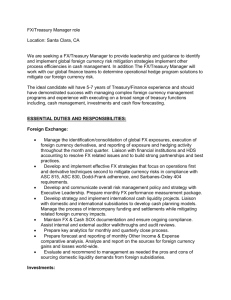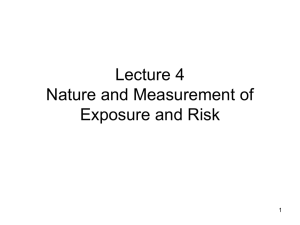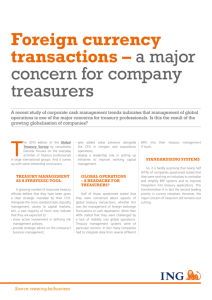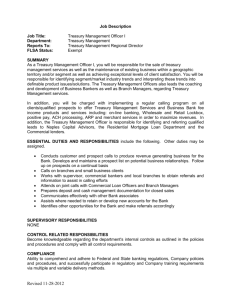Foreign Exchange Management Policy
advertisement
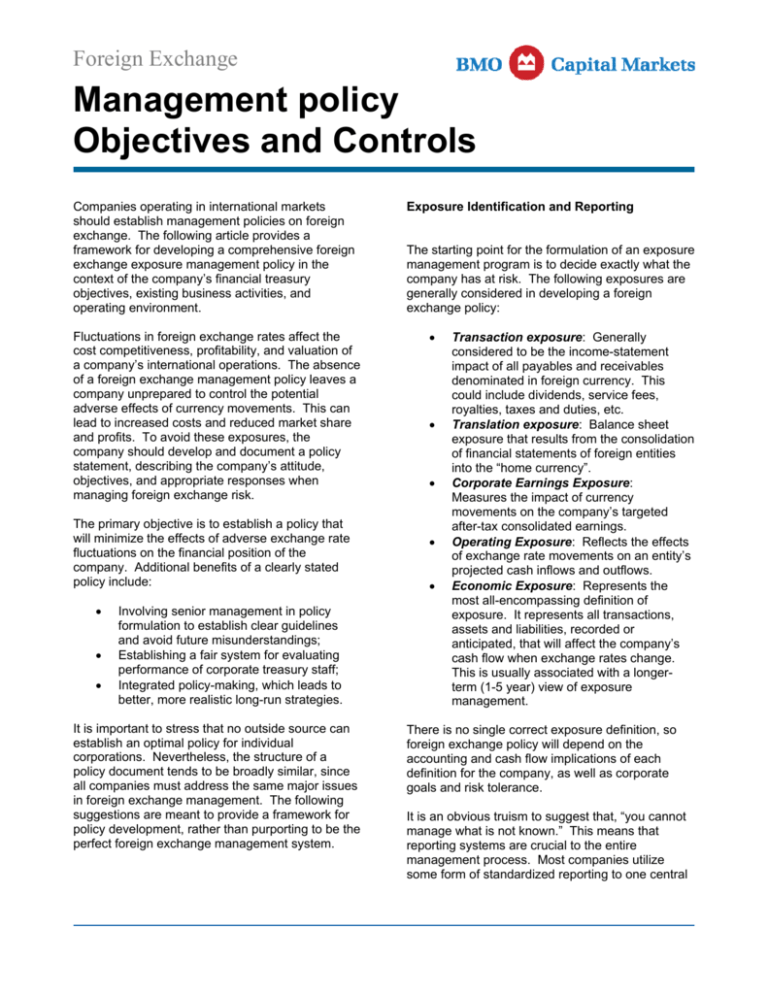
Foreign Exchange Management policy Objectives and Controls Companies operating in international markets should establish management policies on foreign exchange. The following article provides a framework for developing a comprehensive foreign exchange exposure management policy in the context of the company’s financial treasury objectives, existing business activities, and operating environment. Fluctuations in foreign exchange rates affect the cost competitiveness, profitability, and valuation of a company’s international operations. The absence of a foreign exchange management policy leaves a company unprepared to control the potential adverse effects of currency movements. This can lead to increased costs and reduced market share and profits. To avoid these exposures, the company should develop and document a policy statement, describing the company’s attitude, objectives, and appropriate responses when managing foreign exchange risk. The primary objective is to establish a policy that will minimize the effects of adverse exchange rate fluctuations on the financial position of the company. Additional benefits of a clearly stated policy include: • • • Involving senior management in policy formulation to establish clear guidelines and avoid future misunderstandings; Establishing a fair system for evaluating performance of corporate treasury staff; Integrated policy-making, which leads to better, more realistic long-run strategies. It is important to stress that no outside source can establish an optimal policy for individual corporations. Nevertheless, the structure of a policy document tends to be broadly similar, since all companies must address the same major issues in foreign exchange management. The following suggestions are meant to provide a framework for policy development, rather than purporting to be the perfect foreign exchange management system. Exposure Identification and Reporting The starting point for the formulation of an exposure management program is to decide exactly what the company has at risk. The following exposures are generally considered in developing a foreign exchange policy: • • • • • Transaction exposure: Generally considered to be the income-statement impact of all payables and receivables denominated in foreign currency. This could include dividends, service fees, royalties, taxes and duties, etc. Translation exposure: Balance sheet exposure that results from the consolidation of financial statements of foreign entities into the “home currency”. Corporate Earnings Exposure: Measures the impact of currency movements on the company’s targeted after-tax consolidated earnings. Operating Exposure: Reflects the effects of exchange rate movements on an entity’s projected cash inflows and outflows. Economic Exposure: Represents the most all-encompassing definition of exposure. It represents all transactions, assets and liabilities, recorded or anticipated, that will affect the company’s cash flow when exchange rates change. This is usually associated with a longerterm (1-5 year) view of exposure management. There is no single correct exposure definition, so foreign exchange policy will depend on the accounting and cash flow implications of each definition for the company, as well as corporate goals and risk tolerance. It is an obvious truism to suggest that, “you cannot manage what is not known.” This means that reporting systems are crucial to the entire management process. Most companies utilize some form of standardized reporting to one central Foreign Exchange location, unless individual entities are viewed as completely independent. Exposure reporting is a key issue, since treasuries can end up overhedged, underhedged, or unhedged because of inadequate information. Timing is also a key consideration, because market opportunities can slip away while managers wait for information on the direction and size of an exposure. The complexities in defining and reporting appropriate exposures underscore the importance of involving treasury personnel at an early stage of the decision-making process. It is important that the area involved in implementing hedging decisions also be part of the process of defining and reporting exposures. Foreign Exchange Management Objectives and Policy Effective foreign exchange management is a financial tool for ensuring the profitability of the company’s primary business. As such, the company should prepare a comprehensive policy statement on foreign exchange risk that clearly states the company’s objectives, the tactics for attaining these objectives, and the allocation of responsibility for exercising these tactics. Policy Formulation A key requirement when establishing a comprehensive policy for managing foreign exchange exposure is to ensure that the tenets, objectives and procedures set forth in the policy are consistent with the company's existing policies towards the return on foreign investment, and that these procedures meet the need to minimize the negative effects of currency fluctuations on the company’s consolidated earnings position. While the operating philosophy and financial goals of each corporation vary, an effective policy statement for the day-to-day management of foreign exchange risk will cover the following critical parameters: A. Definition of objectives; B. Ranking of exposure priorities; C. Establishment of risk thresholds; D. Allocation of treasury responsibility for exposure management; E. Development of specific guidelines for control and reporting requirements. Objectives and Controls A. Definition of objectives Having identified its foreign exchange exposures, the company should be aware of the exchange rate impact on all aspects of its operations. Hence, the objectives established should reflect management’s tolerance and attitude toward foreign exchange risk and should be clearly stated in the policy. Generally, these objectives fall into two groups: financial objectives and protection objectives. 1. Examples of Financial Objectives: Primary: • To take all reasonable steps to minimize losses resulting from consolidated earnings exposure. Secondary: • To fund worldwide operations at the lowest after-tax cost; • To ensure liquidity for worldwide operations and maintain access to local credit markets; • To protect assets worldwide; • To maximize US dollar profits from overseas operations. While this is not an exhaustive list, it provides some examples to illustrate the point. 2. Examples of Protection Objectives: The company should not hedge its position in a currency when the following conditions prevail: • The risk of loss is minimal; • The cost of covering the position is prohibitive; • The means for covering the position are unavailable in the market. Management should be responsible for ensuring that any action taken to decrease exposure is economically justifiable on an after-tax basis. Protection objectives typically state when not to hedge, and can be expressed in qualitative or quantitative terms. For example, “prohibitive cost” could be specified in dollar terms, or it could be left open to interpretation by an appropriate manager designated in the policy. The main point is to avoid hedging decisions being made without regard to cost and efficiency. Foreign Exchange B. Ranking of Exposure Priorities The company should rank the types of exposures that it faces as a result of fluctuating exchange rates according to their importance to financial, operating and senior management. This prioritization serves as the basis for focusing exposure management efforts and deciding which protective actions the company should employ. The company should review these ranking as operating conditions change. For most companies, the management of transactional and consolidated corporate earnings exposures takes precedence over exposures arising from accounting translation methods. When situations occur in which the company’s earnings are threatened by factors arising from more than one type of exposure, treasury staff should treat the underlying exposure according to the priority assigned by management. C. Establishment of Risk Thresholds For each type of exposure, the company should determine: 1. The level above which a foreign currency exposure requires protective action; 2. The degree of fluctuation in corporate earnings resulting from adverse exchange rate movements; and 3. The amount of cash that the company is willing to expend to reduce and protect exposures. The parameters should reflect the company’s tolerance for foreign exchange risk as well as other operating risks. Risk thresholds may be expressed in a variety of forms: by currency values; as a percentage of earnings by currency or in aggregate; monthly, quarterly, or annually. The company should identify such levels in the context of its size and business. This exercise should ensure that the total cost of hedging, including the cost of personnel and treasury systems, is consistent with the expected benefit from the exposure management process. This will prevent effort being expended on unimportant exposures. D. Allocation of Treasury Responsibilities The first decision in allocating treasury responsibilities is the degree to which foreign exchange management is centralized. In general, hedging control and decision-making flexibility are Objectives and Controls more effective with at least some degree of centralization. However, this issue also depends on overall corporate reporting structures and staffing levels at headquarters and the other offices. The degree of centralization has a direct impact on other issues such as: • • • • Performance evaluation; Organizational structure; Reporting responsibilities; Control structures. In general, most companies find some degree of centralized management is necessary to hedge on the most cost-effective basis from an overall corporate perspective. Once the centralization issues have been addressed, the role of the treasury group can be more specifically defined. The primary exposurerelated responsibilities of treasury usually include the following: • • • • • Determining the level of currency exposure by time period; Monitoring the company’s consolidated exposure; Forecasting exchange rate movements; Deciding which exposure the company must manage; Adjusting the company’s exposed position through measures consistent with the policy’s stated objectives. This involves choosing the hedging instrument as well as the timing of execution. The operating units are responsible for providing treasury (in a timely manner) with the information necessary to determine and monitor the company’s actual and forecast exposure. Operating, marketing and pricing decisions should be taken into account when evaluating exposure concerns, and therefore should include prior consultation with treasury. While hedging the company’s consolidated exposure remains a treasury function, effective management of the company’s diverse exposure depends on close interaction between treasury and line functions. This will allow a swifter response to new market trends and future changes in the company’s exposure profile. Treasury personnel will also be responsible for developing and maintaining market contacts to stay aware of market conditions affecting corporate Foreign Exchange exposures. After using policy-designated criteria to determine which exposures should be managed, treasury then determines the appropriate implementation of the hedge. This procedure should not occur in isolation, but in such a way as to involve the foreign exchange function in the broader corporate decision-making process. This requires interaction with tax, accounting, marketing and other corporate areas that have a stake in foreign exchange management. In addition to allocating corporate responsibilities, a thorough foreign exchange policy must specify approved techniques for hedging exposures. Essentially, four different strategies are available to a company for managing foreign currency risk: 1. 2. 3. 4. Take no action; Trade positions actively; Always hedge everything; Selectively hedge risk. For most companies the first two approaches are impractical alternatives. The third option - to adopt a fully hedged strategy - is costly and offers no flexibility, but does relieve management of the need to take an active decision-making posture. A selective hedging policy, however, relies on economic decision-making as the basis for judging the company’s exposure to risk or, conversely, ability to gain. The company should cover only those exposures where the currency risk exceeds the cost of hedging. Treasury should constantly evaluate and reassess its risk to currency fluctuations and the cost of hedging exposures on a selective basis. A variety of hedging techniques are available for managing currency risk. These techniques may be classified under two groups: internal techniques— those aimed at reducing or preventing an exposed position from arising—and external techniques— typically contractual measures aimed at minimizing exchange losses that may result from an existing exposure. Each company must specify which hedging products are acceptable for managing their exposures. Treasury staff must have clear guidelines within which to function on a day-to-day basis. Objectives and Controls E. Development of Control Procedures and Policies In every trading environment, control procedures should be a fundamental part of the daily routine. This applies equally to corporations, trading banks and institutional traders. Common sense measures can help catch honest errors and will also reduce the likelihood of any improper trading activity. At a minimum, the foreign exchange policy should address the following: • • • • Names of authorized traders with associated trading limits (in terms of contract size); Levels of authority for forward transactions, including far dates (contracts beyond one year); Twenty-four hour trading issues—who is authorized to trade from outside the office and with what parameters; Electronic trading issues. The company should also address the need to batch foreign exchange transactions to meet marketable contract quantities, establish a minimum contract amount, and specify contract tenors consistent with the company’s risk attitude. The maintenance of up-to-date records of foreign exchange activity will facilitate the monitoring and evaluation of hedging strategies. These records should be reviewed on a regular basis by senior management to ensure compliance with established policies. New product development poses additional issues for a corporate foreign exchange policy. This requires specification of what products can be traded, the limits that apply, and the development of a review procedure to evaluate new products that may emerge in the future. Hybrid products can pose definitional problems that must be addressed to avoid confusion. For example, is a forward participation agreement a forward or an option for control and reporting purposes? The product functions like a “flexible forward” but is actually a hybrid options product. These nuances may seem trivial, but they can produce serious problems for a treasury manager trying to explore alternative hedging strategies. Foreign Exchange Effective foreign exchange policy also needs to address confirmations and record keeping, whether paper or electronic. Most companies expect sameday telephone confirmations for each trade, and specify that someone other than the original trader must verbally confirm the deal. Written confirmations are generally sent to a separate area from the trading function—usually a control or audit division of the company. They should obviously be sent to the attention of someone other that the initiator of the transaction. Both verbal and written confirmations must be checked carefully. Any discrepancies must be immediately resolved with the counterparty to the trade, to avoid major trading losses. Corporate control areas can monitor written confirmations to ensure adherence to foreign exchange policies and guidelines. The confirmation process not only helps avoid or reduce serious trade disputes, it also provides a valuable internal check from a policy enforcement perspective. While banks can help in the control process, each corporation is ultimately responsible for its own internal control. No outside entity can police a company’s operations. Companies and their banks must work together to minimize the risk of errors or improper trading. Conclusion The policy formulation process is not difficult on the surface. It is the thorny issues and debates that emerge that tend to scuttle development and implementation of a sound foreign exchange management policy. The basic development process can be summarized as follows: A. Examine current practices and past experience with regard to foreign exchange management. B. Define and evaluate exposures, both actual and projected. Evaluate effectiveness of past hedging actions if feasible. C. Formulate policy guidelines: 1. Establish priorities for managing exposures. 2. State corporate objectives clearly. 3. Ensure compatibility with other corporate goals and philosophies. 4. Obtain senior management mandate. Objectives and Controls D. Develop operational structure: 1. Decide on degree of centralization. 2. Evaluate reporting systems and implement needed changes. 3. Specify approved hedging techniques. 4. Specify key decision makers/authorized traders. 5. Develop performance evaluation standards. 6. Establish transaction reporting requirements and procedures. 7. Provide for management review of outstanding contracts and activity. E. Establish a procedure for regular reviews of foreign exchange policies and guidelines. A good policy provides positive framework for action, with room for appropriate modifications and changes over time. F. Utilize policy review, goal setting, and policy implementation to encourage the integration of foreign exchange management into the broader corporate decision-making process. This will lead to more informed decision-making and result in fewer surprises in the future. In the proper context, a foreign exchange management policy serves several important functions in addition to the critical control function. An effective policy also helps in assessing treasury performance, providing a framework for analysis, and involving the foreign exchange function in broader corporate decision-making. These benefits can be just as important as the control issues addressed by a formalized policy.
